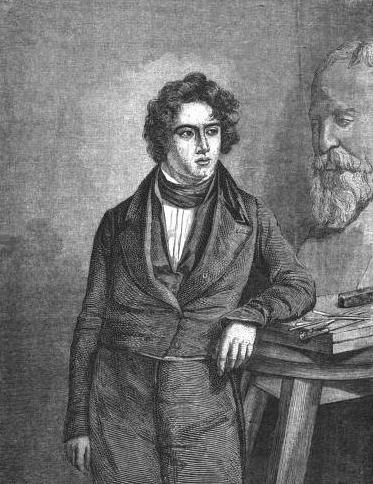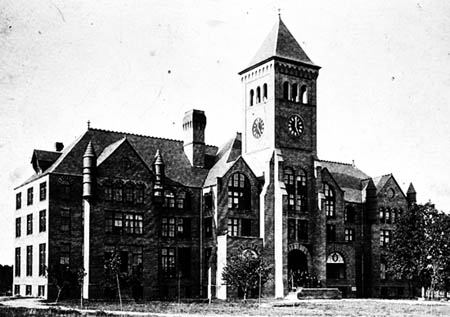|
Claude Pouteau
Claude Pouteau (born August 14, 1724, in Lyon, and died February 10, 1775, in the same city) was a French surgeon and inventor. Biography Claude Pouteau was the son of a surgeon, from whom he received his first medical education. He then studied in Paris, where he had as masters Jean-Louis Petit, Henri François Le Dran and Sauveur François Morand. Once his thesis was defended, he returned to Lyon, where he was appointed junior surgeon at the Hôtel-Dieu in 1744. He succeeded Pierre Grassot as major surgeon at the Hôtel-Dieu and continued, like the latter, to promote vaccination against smallpox. In 1753 he turned to private practice, where he was very successful. In 1755 he was made a member of the Academy of Sciences, Belles-Lettres et Arts de Lyon. Pouteau was a very human doctor. For example, he put an end to the lithotomy operations performed in a row (the spectators saw several operations, but the patients were waiting amidst the cries of those who preceded them). ... [...More Info...] [...Related Items...] OR: [Wikipedia] [Google] [Baidu] |
Lyon
Lyon,, ; Occitan: ''Lion'', hist. ''Lionés'' also spelled in English as Lyons, is the third-largest city and second-largest metropolitan area of France. It is located at the confluence of the rivers Rhône and Saône, to the northwest of the French Alps, southeast of Paris, north of Marseille, southwest of Geneva, northeast of Saint-Étienne. The City of Lyon proper had a population of 522,969 in 2019 within its small municipal territory of , but together with its suburbs and exurbs the Lyon metropolitan area had a population of 2,280,845 that same year, the second most populated in France. Lyon and 58 suburban municipalities have formed since 2015 the Metropolis of Lyon, a directly elected metropolitan authority now in charge of most urban issues, with a population of 1,411,571 in 2019. Lyon is the prefecture of the Auvergne-Rhône-Alpes region and seat of the Departmental Council of Rhône (whose jurisdiction, however, no longer extends over the Metropolis of Lyo ... [...More Info...] [...Related Items...] OR: [Wikipedia] [Google] [Baidu] |
Gangrene
Gangrene is a type of tissue death caused by a lack of blood supply. Symptoms may include a change in skin color to red or black, numbness, swelling, pain, skin breakdown, and coolness. The feet and hands are most commonly affected. If the gangrene is caused by an infectious agent, it may present with a fever or sepsis. Risk factors include diabetes, peripheral arterial disease, smoking, major trauma, alcoholism, HIV/AIDS, frostbite, influenza, dengue fever, malaria, chickenpox, plague, hypernatremia, radiation injuries, meningococcal disease, Group B streptococcal infection and Raynaud's syndrome. It can be classified as dry gangrene, wet gangrene, gas gangrene, internal gangrene, and necrotizing fasciitis. The diagnosis of gangrene is based on symptoms and supported by tests such as medical imaging. Treatment may involve surgery to remove the dead tissue, antibiotics to treat any infection, and efforts to address the underlying cause. Surgical efforts may include debr ... [...More Info...] [...Related Items...] OR: [Wikipedia] [Google] [Baidu] |
1724 Births
Seventeen or 17 may refer to: *17 (number), the natural number following 16 and preceding 18 * one of the years 17 BC, AD 17, 1917, 2017 Literature Magazines * ''Seventeen'' (American magazine), an American magazine * ''Seventeen'' (Japanese magazine), a Japanese magazine Novels * ''Seventeen'' (Tarkington novel), a 1916 novel by Booth Tarkington *''Seventeen'' (''Sebuntiin''), a 1961 novel by Kenzaburō Ōe * ''Seventeen'' (Serafin novel), a 2004 novel by Shan Serafin Stage and screen Film * ''Seventeen'' (1916 film), an American silent comedy film *'' Number Seventeen'', a 1932 film directed by Alfred Hitchcock * ''Seventeen'' (1940 film), an American comedy film *''Eric Soya's '17''' (Danish: ''Sytten''), a 1965 Danish comedy film * ''Seventeen'' (1985 film), a documentary film * ''17 Again'' (film), a 2009 film whose working title was ''17'' * ''Seventeen'' (2019 film), a Spanish drama film Television * ''Seventeen'' (TV drama), a 1994 UK dramatic short starring Chris ... [...More Info...] [...Related Items...] OR: [Wikipedia] [Google] [Baidu] |
French Surgeons
French (french: français(e), link=no) may refer to: * Something of, from, or related to France ** French language, which originated in France, and its various dialects and accents ** French people, a nation and ethnic group identified with France ** French cuisine, cooking traditions and practices Fortnite French places Arts and media * The French (band), a British rock band * "French" (episode), a live-action episode of ''The Super Mario Bros. Super Show!'' * ''Française'' (film), 2008 * French Stewart (born 1964), American actor Other uses * French (surname), a surname (including a list of people with the name) * French (tunic), a particular type of military jacket or tunic used in the Russian Empire and Soviet Union * French's, an American brand of mustard condiment * French catheter scale, a unit of measurement of diameter * French Defence, a chess opening * French kiss, a type of kiss involving the tongue See also * France (other) * Franch, a surname * French ... [...More Info...] [...Related Items...] OR: [Wikipedia] [Google] [Baidu] |
Augustin De Saint-Aubin
Augustin de Saint-Aubin sometimes styled Auguste de Saint-Aubin (3 January 1736 – 9 November 1807), belongs to an important dynasty of French designers and engravers. Biography Augustin de Saint-Aubin was born on 3 January 1736 in Paris to the king's embroiderer Gabriel Germain de Saint-Aubin (1696–1756). He came from a family of artists and designers, which included his six siblings: brothers Charles-Germain de Saint-Aubin and Gabriel-Jacques de Saint-Aubin, as well as Catherine Louise, Louis-Michel, Athanasius, and Agathe, who were collectively known as the "Book of Saint-Aubin". His niece, Marie-François, daughter of Charles, was an artist as well. in the ''Dictionary of Pastellists Before 1800''. Trained by his brother, he later studied with [...More Info...] [...Related Items...] OR: [Wikipedia] [Google] [Baidu] |
Montpellier
Montpellier (, , ; oc, Montpelhièr ) is a city in southern France near the Mediterranean Sea. One of the largest urban centres in the region of Occitania (administrative region), Occitania, Montpellier is the prefecture of the Departments of France, department of Hérault. In 2018, 290,053 people lived in the city, while its Functional area (France), metropolitan area had a population of 787,705.Comparateur de territoire INSEE, retrieved 20 June 2022. The inhabitants are called Montpelliérains. In the Middle Ages, Montpellier was an important city of the Crown of Aragon (and was the birthplace of James I of Aragon, James I), and then of Kingdom of Majorca, Majorca, before its sale to France in 1349. Established in 1220, the University of Montpellier is one of the List of oldest univ ... [...More Info...] [...Related Items...] OR: [Wikipedia] [Google] [Baidu] |
Jean-François Legendre-Héral
Jean-François Legendre-Héral (21 January 1796, Montpellier – 13 September 1851, Marcilly) was a French classical sculptor. Biography Jean-Francois Legendre-Heral was born on 21 January 1796 in Montpellier. His father was a postal worker. After his father's death, his mother married a musician, who introduced him to the arts. He was soon allowed to enroll in the École nationale des beaux-arts de Lyon, where he studied with Joseph Chinard and Joseph Charles Marin. In 1817, he obtained a grant from the city for a study trip to Rome. It was at this time that he added his step-father's name to his own to become Legendre-Héral. During his stay there, his fellow sculptor James Pradier accused him of casting his sculptures from life; an accusation that would later become the source of rumours in Lyon and Paris, apparently spread by François Joseph Bosio. In 1819, he was named to a professorship at the École, where Jean-Marie Bonnassieux and Hippolyte Flandrin were among his f ... [...More Info...] [...Related Items...] OR: [Wikipedia] [Google] [Baidu] |
Louis Jacques Bégin
Louis Jacques Bégin (2 November 1793, Liège – 13 April 1859) was a French military physician. He began his medical studies in the military hospital at Metz, subsequently serving as an assistant surgeon in the Napoleonic Wars (Russian and German campaigns). From 1815 he was associated with the civil hospital in Strasbourg, followed by an appointment at Val de Grace. In 1823 he obtained his doctorate at the University of Strasbourg, where in 1832 he became a lecturer in anatomy, physiology and surgery. Among his students at Strasbourg was obstetrician François Joseph Herrgott (1814–1907). From 1835 he worked in Paris. In 1832, he was appointed surgeon-major, and in 1842, he became a member of the ''Conseil de santé des armées'' (Sanitary council of the French armies), of which he served as president from 1850 to 1857. In 1847 he was elected president of the Académie de Médecine. With Louis Joseph Sanson (1790–1841), he published new editions of Raphael Bie ... [...More Info...] [...Related Items...] OR: [Wikipedia] [Google] [Baidu] |
Duke University
Duke University is a private research university in Durham, North Carolina. Founded by Methodists and Quakers in the present-day city of Trinity in 1838, the school moved to Durham in 1892. In 1924, tobacco and electric power industrialist James Buchanan Duke established The Duke Endowment and the institution changed its name to honor his deceased father, Washington Duke. The campus spans over on three contiguous sub-campuses in Durham, and a marine lab in Beaufort. The West Campus—designed largely by architect Julian Abele, an African American architect who graduated first in his class at the University of Pennsylvania School of Design—incorporates Gothic architecture with the Duke Chapel at the campus' center and highest point of elevation, is adjacent to the Medical Center. East Campus, away, home to all first-years, contains Georgian-style architecture. The university administers two concurrent schools in Asia, Duke-NUS Medical School in Singapore (established in ... [...More Info...] [...Related Items...] OR: [Wikipedia] [Google] [Baidu] |
Joint Dislocation
A joint dislocation, also called luxation, occurs when there is an abnormal separation in the joint, where two or more bones meet.Dislocations. Lucile Packard Children’s Hospital at Stanford. Retrieved 3 March 2013 A partial dislocation is referred to as a subluxation. Dislocations are often caused by sudden trauma on the joint like an impact or fall. A joint dislocation can cause damage to the surrounding ligaments, tendons, muscles, and nerves. Dislocations can occur in any major joint (shoulder, knees, etc.) or minor joint (toes, fingers, etc.). The most common joint dislocation is a shoulder dislocation. Treatment for joint dislocation is usually by closed reduction, that is, skilled manipulation to return the bones to their normal position. Reduction should only be performed by trained medical professionals, because it can cause injury to soft tissue and/or the nerves and vascular structures around the dislocation. Symptoms and signs The following symptoms are common with ... [...More Info...] [...Related Items...] OR: [Wikipedia] [Google] [Baidu] |
Fistula
A fistula (plural: fistulas or fistulae ; from Latin ''fistula'', "tube, pipe") in anatomy is an abnormal connection between two hollow spaces (technically, two epithelialized surfaces), such as blood vessels, intestines, or other hollow organs. Types of fistula can be described by their location. Anal fistulas connect between the anal canal and the perianal skin. Anovaginal or rectovaginal fistulas occur when a hole develops between the anus or rectum and the vagina. Colovaginal fistulas occur between the colon and the vagina. Urinary tract fistulas are abnormal openings within the urinary tract or an abnormal connection between the urinary tract and another organ such as between the bladder and the uterus in a vesicouterine fistula, between the bladder and the vagina in a vesicovaginal fistula, and between the urethra and the vagina in urethrovaginal fistula. When occurring between two parts of the intestine, it is known as an enteroenteral fistula, between the small intest ... [...More Info...] [...Related Items...] OR: [Wikipedia] [Google] [Baidu] |
.jpg)





